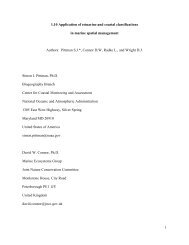A Benthic Terrain Classification Scheme for American Samoa
A Benthic Terrain Classification Scheme for American Samoa
A Benthic Terrain Classification Scheme for American Samoa
Create successful ePaper yourself
Turn your PDF publications into a flip-book with our unique Google optimized e-Paper software.
transitional areas (e.g. narrow crests and lateral midslope features) often correspond with<br />
mixed substrates or rubble. This analysis is continuing to find relationships between BPI<br />
zones/structures and percentages of living cover (e.g. Coralline Algae, Scleractinian<br />
Coral, Macroalgae), scale of relief (i.e. 5 categories ranging from less than 0.5 m - > 3.0<br />
m), and number/size of cavities noted in the frame (e.g. few small and many large<br />
cavities, many small cavities). The analysis is evolving into a product that will validate<br />
interpolations of coral cover and substrate type across the region; it will eventually<br />
provide a prototype habitat map and methods that may be applied to other Pacific Island<br />
regions.<br />
Figure 12 BPI Structures overlaid with optical validation. This is a sample from the<br />
Saipan anchorage data set that was surveyed by CRED in 2003 and 2004. The structures<br />
were derived from a bathymetric grid (5-m pixel size), and the optical validation<br />
represents interpretations of videos from a towed underwater video camera-sled. A<br />
qualitative assessment validates a pattern of associations between substrates and BPI<br />
structures.<br />
33
















